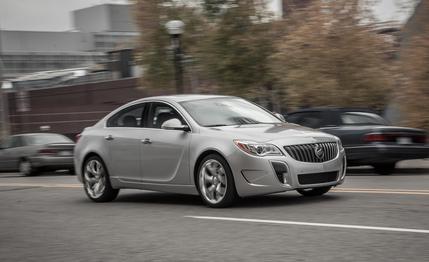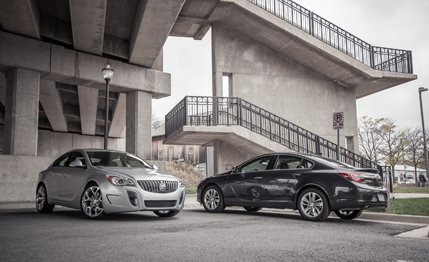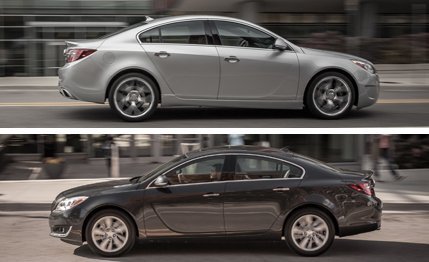
 Instrumented Test
TESTED
Instrumented Test
TESTED
Since its return for 2012 on the top-grade Regal, Buick’s legendary GS badge has injected some much-needed cred into GM’s sleepiest brand. (The letters might soon be applied to more models, too.) Serving up a Euro-style balance of sport and luxury, the Regal GS boasted its own tune for the 2.0-liter turbo four that provided cushions of 50 horsepower and 35 lb-ft of torque over the same engine in the mid-grade Regal Turbo. But a Regal refresh for 2014 sees an updated powerplant installed in both models, a move that has fortified the Turbo but weakened the GS. Although GS performance doesn’t suffer from the swap, a stronger Turbo brings the chief Regal’s value into question.
More or Less Power, You Decide
The new engine is a 2.0-liter four-cylinder with a twin-scroll turbocharger, a forged steel crankshaft, direct injection, and twin balance shafts. With maximum boost of 24 psi, the engine produces 259 horsepower and 295 lb-ft of torque; the GS thus sees a drop of 11 horses (torque stays the same), while the Turbo gains 39 horsepower and 35 lb-ft. Different engine maps have the GS making maximum torque at 2500 rpm versus 3000 in the Turbo, but horsepower in both versions tapers off after a 5300-rpm peak. A six-speed manual transmission is again offered on the front-wheel-drive GS, with GM’s six-speed 6T70 automatic the default choice for GS AWD models and the only gearbox for Turbos.


This year also brings a new, optional Haldex all-wheel-drive system that can shuttle up to 90 percent of the power to the rear wheels, as well as an electronic limited-slip differential that apportions torque to either side of the rear axle. As you might have surmised from the headline on this story, we tested versions of the Turbo and the GS with this system. Along with bolstering appeal among Snowbelters and fattening MSRPs (an additional $2175 for the Turbo, $2365 for the GS), the AWD hardware puts both models over the two-ton mark on our scales, nearly 300 more pounds than front-wheel-drive versions we’ve tested.
Despite their extra weight, turbocharged AWD Regals achieve the same 22-mpg combined EPA rating as did 2013 front-drivers, with the 2014 FWD models now garnering 24-mpg estimates. Our AWD Turbo test car managed 20 mpg in the real world and the AWD GS 19, numbers similar to those gathered from previous front-drive test cars.
What Extra Weight?
The AWD Turbo and GS defy their bloat at the test track as well, running quicker to 60 and the quarter-mile mark than their lighter, front-drive predecessors with automatics. That means 6.6 seconds and 15 flat for the 2014 Turbo (versus 7.5 and 15.7) and 6.2 and 14.7 seconds for the new GS (versus 6.4 and 15.0). The GS doesn’t feel quicker by the seat of your pants, but its slightly lower torque peak, the all-wheel-drive system, and a set of sticky Pirelli P Zero tires on optional 20-inch wheels help it get out of the hole quickly. It’s worth noting that we had to test a second, essentially identical GS after our first test car suffered a catastrophic engine failure due to faulty connecting-rod bearings.


Larger front brakes (wearing Brembo branding) and fat rollers give the GS a decelerative edge over the Turbo, with the stop from 70 mph coming in a fade-free 153 feet. The all-season-shod Turbo turned in a 163-foot number. Both models are stable and quiet up to their drag-limited top speeds. We were unable to measure lateral grip with the new AWD system, but don’t expect much to change from the front-drive versions, which posted 0.85 g (Turbo) and 0.90 g (GS on the Pirellis).
Moderated Performance
All-wheel-drive Regals feature a control-arm rear suspension in place of FWD cars’ multilink setups, with the GS continuing to wield front Hi-Per struts in the fight against torque steer. (The Turbo has conventional struts.) As with launches, hasty exits from tight corners are drama-free in both cars, thanks to excellent traction and minimal turbo lag, but the Hi-Per struts do gift the racier Regal a greater sense of confidence on turn-in. The GS also feels sharper and marginally more attuned to requests from the helm.